 |
||
|
||
| ||
Arctic Cooling, Cooler Master, and GlacialTechContents:
Paying close attention to various cooling systems for CPUs, GPUs, hard drives, etc., we often take no notice of some very important parts of these - fans. In practice, today fans are not just some cooling parts. They have obtained the status of independent products — that's how fans of the most popular sizes (80x80x25 mm, 92x92x25 mm, and 120x120x25 mm) are perceived now. A similar metamorphosis happened to CPU coolers that are gaining higher position in the hierarchy of cooling systems. For example, they were just like an alternate set of sundries in the end of 90s of the last century. Even major computer stores could offer only a couple of simple coolers to replace the standard models installed on Intel Pentium 100 or AMD K5 133. As for now, coolers are an active and significant segment of the computer market. Its growth rates are much better than in many traditional IT fields. It is not inconceivable that fans will play just as important role, considering the current market trend to promote PCs as consumer electronics (in other words, computers are becoming entertainment centers to replace many consumer AV devices) as well as support for a new class of products - DIY coolers, which offer enthusiasts lots of options. The situation in the fan camp is evolving and we cannot ignore it. Today we are going to examine a group of 25 products (80x80x25 mm and 120x120x25 mm) from Arctic Cooling, Cooler Master, GlacialTech, Scythe, Titan, and Zalman. We'll analyze their technical and functional properties. OK, let's start the ball rolling! Arctic Cooling Arctic Fan 8, Arctic Fan 8L, Arctic Fan 12, and Arctic Fan 12LThe shootout starts with models from Arctic Cooling — "inverted" Arctic Fan 8 (80x80x38 mm, 2000 rpm) and Arctic Fan 12 (120x120x38 mm, 1500 rpm).  A distinctive (practically unique) feature of Arctic Fan 8 and Arctic Fan 12 is their crafty case design — there is no case as such, a stator with an impeller are mounted on a frame with a special rubber suspension system to dampen vibrations. We should also mention the inverted stator-impeller block. Owing to this design, the impeller rotates clockwise (the other standard fans rotate counterclockwise), which may be a considerable advantage for unusual usage of Arctic Fan 12 (it will be described later). 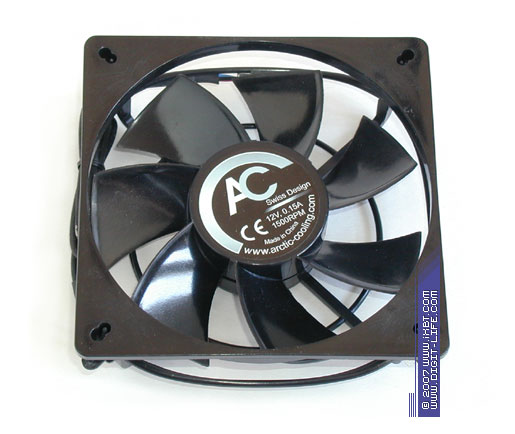 These models are also well designed in terms of aerodynamics — the seven-blade impeller of Arctic Fan 8 and Arctic Fan 12 features a weighted selection of parameters intended to minimize noise and provide sufficient performance potential. Arctic Fan 8: sweep and lean blade, variable blade chord (the distance between the front and rear edges of the blade) — 20 mm at the inner diameter (at the hub) and 28 mm at the outer diameter of the blade, tight arrangement of blades — solidity factor (chord-pitch ratio) is 1.25 at the hub and 0.87 at the outer diameter, normalized attack angles — 50° at the hub and 35° at the outer diameter, hub-tip ratio - 0.47. 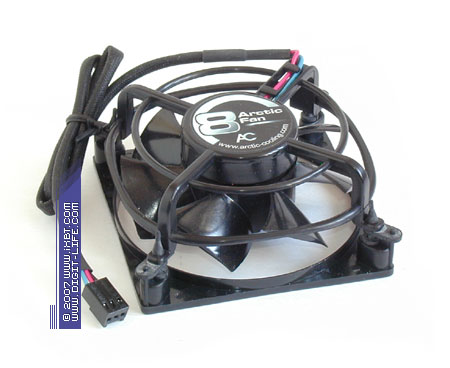 Arctic Fan 12: sweep and lean blade, variable blade chord — 24 mm long at the hub and 33 mm at the tip, chord-pitch ratio - 1.2 at the hub and 0.66 at the tip, sparing angles of attack — 40° at the hub and 25° at the outer diameter, hub-tip ratio - 0.43. 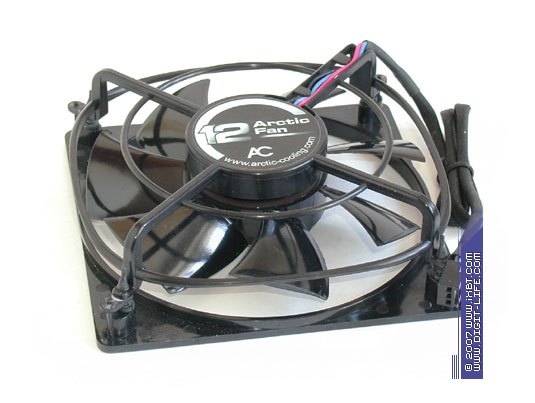 While Arctic Fan 8 and Arctic Fan 12 look very well in aerodynamic terms, the technical image of these fans fades a little in mechanical terms — although they are equipped with improved sleeve bearing (this one consists of two sleeves — inner surface of the first sleeve is polished and mated with the shaft, the second has a larger inner diameter and rough surface covered with soft lubricant that holds oil), this is hardly "fluid dynamic bearing " (according to Arctic Cooling specs). 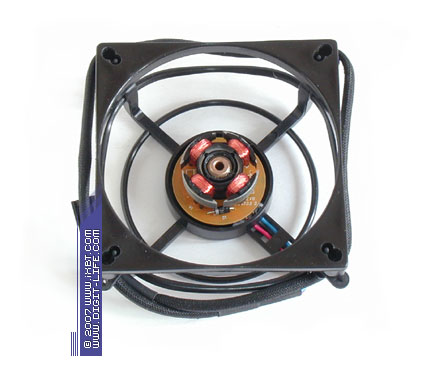 We also have some gripes with the electric binding of the engine — the inductor is controlled by a simple Anpec APX9140 chip, which only advantage is its ability to work with low voltages — starting from 3 V. There are no additional smoothing capacitors, which are usually used in such circuits to clip reverse voltage surges and protract the front-decay of switching impulses in the inductor coil. It leads to a noticeable component in fan noise - co-called engine popping (noises in the stator-impeller block caused by switching inductor coils). And perhaps the biggest gripe — performance of Arctic Fan 8 and Arctic Fan 12. Despite the advanced impeller, these fans demonstrate weak performance in our testbed. They are outperformed by practically all contenders. The situation with noise characteristics is ambiguous as well (especially what concerns Arctic Fan 12). To all appearances, it's the fault of the open frameless design of Arctic Fan 8 and Arctic Fan 12 — the impeller actually works in the propeller mode here - with intensive vortex formation and significant pressure loss. As a result, fan performance slumps in a section with high impedance (our reference test heatsink), they generate minimum airflow. When in slow mode (1500 rpm for Arctic Fan 8 and 700 rpm for Arctic Fan 12), there is practically no effect from them. What concerns the other two Arctic Fans — Arctic Fan 8L and Arctic Fan 12L, they are complete aerodynamical copies of Arctic Fan 8 and Arctic Fan 12 and differ in lower speed (1500 rpm in Arctic Fan 8L and 1000 rpm in Arctic Fan 12L). 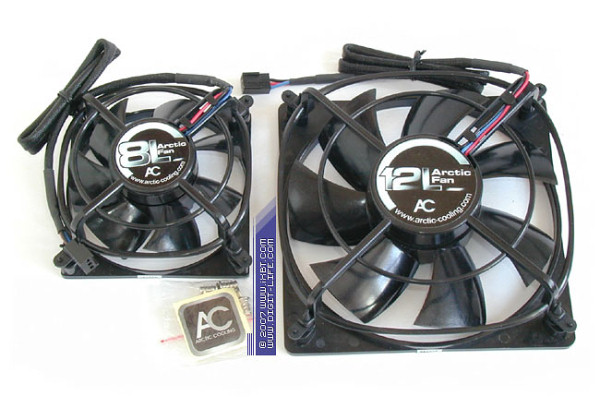 There are no differences in technical and functional terms either, except for control electronics — Arctic Fan 8L and Arctic Fan 12L use the popular ATS277 chip, they are equipped with smoothing capacitors and demonstrate improved noise characteristics, owing to silenced popping of the engine. Cooler Master SAF-B83-E1-GP and OAF-L12-E1The next fans in our list are budget models from Cooler Master — SAF-B83-E1-GP and OAF-L12-E1. 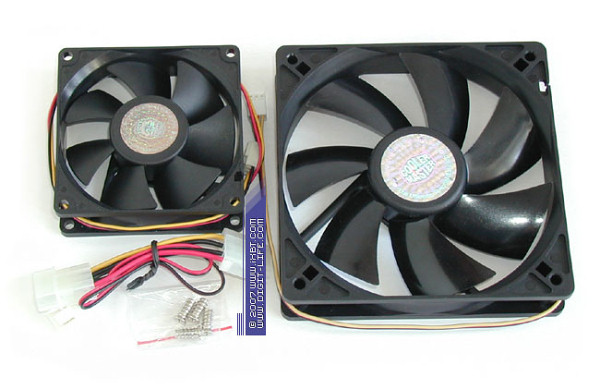 SAF-B83-E1-GP is an ordinary fan - it offers no supernatural technical features. It has a usual 80x80x25 mm case (4 stator carriers), 7-blade impeller (nominal speed - 2500 rpm), and combined mechanics of budget quality (simple sleeve bearing plus rolling bearing). 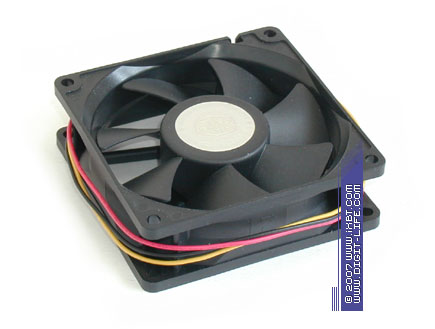 However, budget origins of SAF-B83-E1-GP do not negate its neat impeller with good aerodynamic parameters designed to improve noise characteristics: sweep and lean blades, chord - 20 mm at the hub and 30 mm at the tip, chord-pitch ratio - 1.25 at the hub and 1 at the outer diameter, angles of attack - 45° at the hub and 30° at the outer diameter, hub-tip ratio - 0.46, tip clearance - 2 mm. 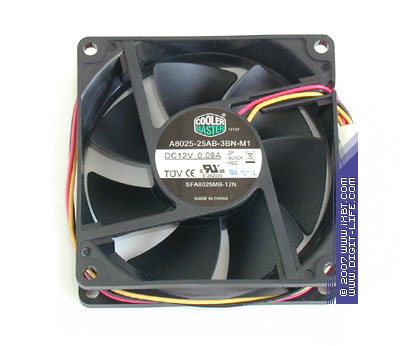 In practice, possessing aerodynamically well-balanced impeller, the SAF-B83-E1-GP demonstrates good performance in the standard mode as well as at 1500 rpm. It's slightly outperformed by the more expensive SAF-S84-E1-GP. This model is quiet as well, its noise level is not high for its standard fan speed. What concerns the electric binding of the fan engine, the budget SAF-B83-E1-GP model is not very good — the control circuit is based on the ATS278 chip (similar to ATS276/277) and lacks smoothing capacitors. It's done to reduce the costs. As a result, the engine is audibly popping. 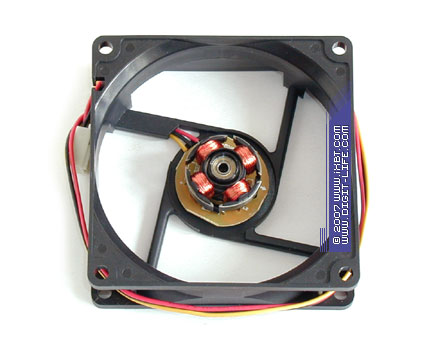 Another representative of the budget family of Cooler Master (OAF-L12-E1) does not pretend to be an outstanding fan — being an ordinary 120x120x25 mm model, it offers a slimmed-down case and 7-blade impeller (nominal 1600 rpm). 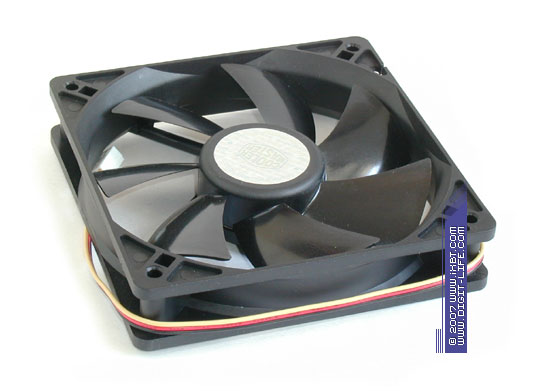 As in case with the SAF-B83-E1-GP, aerodynamic configuration of the OAF-L12-E1 impeller is designed for reduced noise: sweep and lean blades, the chord is 20 mm at the hub and 35 mm at the tip, chord-pitch ratio - 1 at the hub and 0.7 at the tip, angles of attack - 35° at the hub and 20° at the tip, 0.38 hub-tip ratio, 1.5 mm tip clearance. 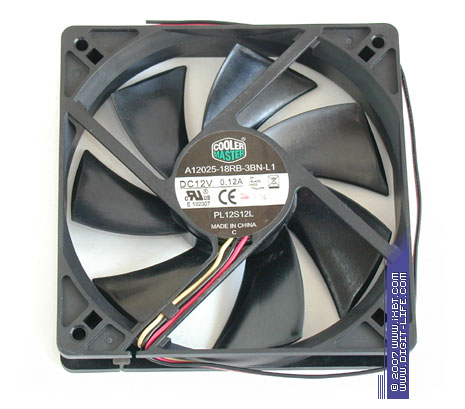 What concerns mechanics, the sleeve-type OAF-L12-E1 looks more promising than the combined-type SAF-B83-E1-GP — this sleeve bearing can boast of improved design with several radial incisions on the inner surface and spiral grooves at the ends to hold and recirculate lubricant in the sleeve. We should also note a dust cap mounted on the hub that covers the bearing. 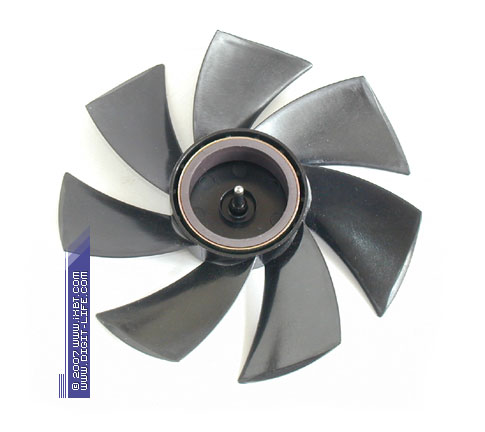
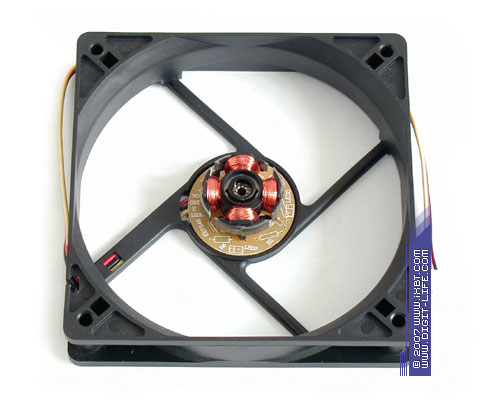 But the electrical situation still leaves much to be desired — the inductor (which coil is not very tidy) is controlled by the ATS276 chip. Besides, the circuits should have incorporated smoothing capacitors. But there aren't any with all natural consequences — popping of the OAF-L12-E1 engine is audible. In practice, the OAF-L12-E1 demonstrates acceptable efficiency in our testbed, both in the standard mode and at 1000 rpm. But performance drops significantly in a slower mode (700 rpm). It looks like the sparing aerodynamics of the impeller is not efficient at low speed and cannot generate a steady airflow with acceptable static pressure. Cooler Master SAF-S84-E1-GP and SAF-S12-E1-GPNow we shall examine two High-End fans from Cooler Master — SAF-S84-E1-GP and SAF-S12-E1-GP.  SAF-S84-E1-GP is a typical delta-representative of 80x80x25 mm fans (made by Delta Electronics — an old OEM partner of Cooler Master, AUB0812L model). A sturdy well-engineered case, an impeller with aggressive aerodynamic configuration, high-quality mechanics — they have become a part of technical image of delta models. 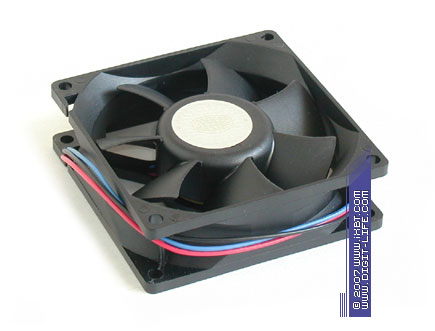 Indeed, a 7-blade impeller of the SAF-S84-E1-GP is notable for the combination of parameters to balance noise/performance characteristics. So the fan has a good aerodynamic potential — sweep and lean blade, the chord is 22 mm at the hub and 28 mm at the tip, the chord-pitch ratio is 1.37 at the hub and 0.87 at the tip, angles of attack - 50° and 35°, 0.49 hub-tip ratio, 1.5 mm tip clearance. Fortunately, it does not miss a change to show its worth in practice. Owing to its optimized impeller, it demonstrates decent performance at 1500 rpm, it's only slightly outperformed by GlacialTech SilentBlade and SilentBlade II. 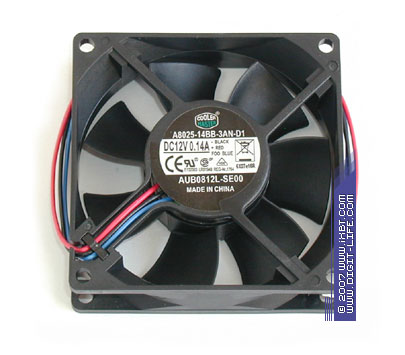 The SAF-S84-E1-GP is good at mechanics as well — the fan is equipped with imposing hydrodynamic bearing (a sleeve made of special bronze alloy, hydrodynamic incisions on the inner diameter) and protection from dust and moisture both in the stator (the stator block is nonseparable) and under the hub of the impeller. This model also looks good from the electric point of view — it features a high-quality inductor and electric binding based on advanced Sanyo LB1668M (it can generate up to 1.5 A and has a built-in protection from impeller locks). However, there are no smoothing capacitors here, which must have been installed at the output of inductor's drivers. As a result, the SAF-S84-E1-GP whirrs, even though its "equivalent" noise level is low. 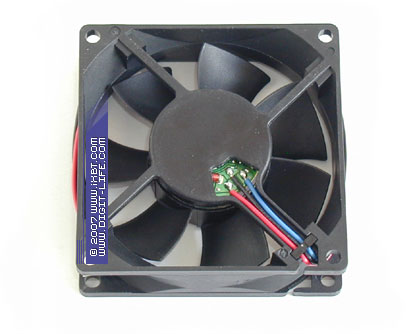 The SAF-S12-E1-GP delta model from Cooler Master (120x120x25 mm, 700 rpm) has more to boast of. 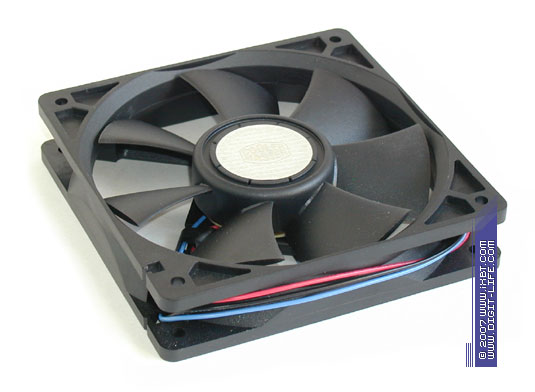 First of all, it's a neat impeller with its noise characteristics being of top priority again: sweep and lean blades, the chord is 22 mm at the hub and 38 mm at the tip, chord-pitch ratio - 1 at the hub and 0.79 at the tip, angles of attack - 40° and 20°, 0.43 hub-tip ratio, 1.5 mm tip clearance. The impeller of the SAF-S12-E1-GP model also features a technical trick — scooped blade, which raises its efficiency. 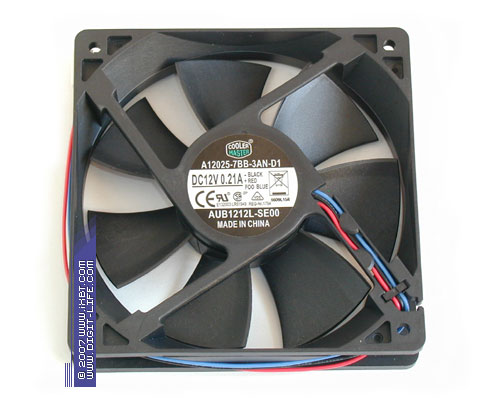 The SAF-S12-E1-GP is no worse in mechanical terms, being equipped with hydrodynamic bearing similar to that in the SAF-S84-E1-GP. The bearing unit is spiced up with an additional benefactor — a magnetic ring built into the center of the stator's backing plate for better impeller balance. There are some changes in electric circuits as well — the control circuit is based on Sanyo LB1663M (a counterpart of LB1668) and incorporates capacitors to smooth engine popping. 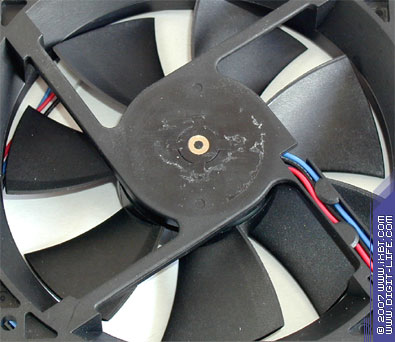 Ring magnet in stator As a result, the SAF-S12-E1-GP is a very interesting high-quality product with good components and serious aerodynamic potential. However, its overall technical image is spoilt a little by an unexpected factor — low fan speed (just 700 rpm) has a good effect on noise characteristics, of course. But the resulting performance of the SAF-S12-E1-GP leaves much to be desired and limits its possible applications. To all appearances, Cooler Master could have had faster models in this series. GlacialTech GT8025-HDLA1, GT8025-EDLA1, GT12025-HDLA1, and GT12025-EDLA1And now we'll examine representatives of the updated SilentBlade II family from GlacialTech — GT8025-HDLA1 (80x80x25 mm, 1800 rpm) and GT12025-HDLA1 (120x120x25 mm, 1000 rpm). 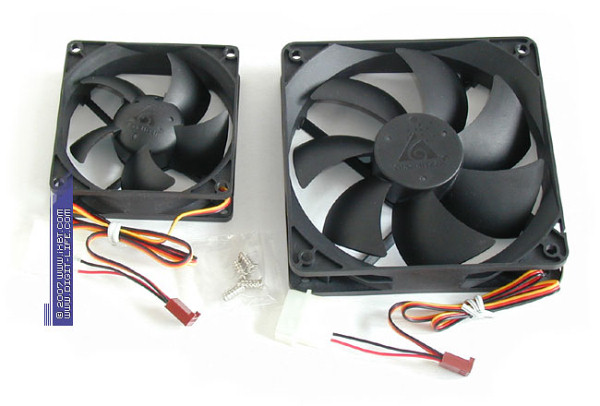 Despite their budget origins, both fans demonstrate a number of technically refined aerodynamic and mechanical features. The most interesting configuration is demonstrated by the cheapest model — GT8025-HDLA1. Its 5-blade impeller is unique (for budget and Mid-End fans) and features a truly optimized set of parameters: sweep and lean blades, the chord is 24 mm at the hub and 30 mm at the tip, chord-pitch ratio is 1.2 at the hub and 0.67 at the outer diameter, aggressive angles of attack — 55° and 40°, 0.43 hub-tip ratio, 1.8 mm tip clearance. Accompanied by various tricks (special form of the hub and inner blade surface), it gives the GT8025-HDLA1 a good chance to achieve high efficiency and ergonomic noise characteristics. 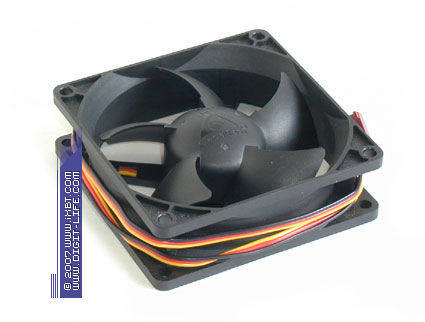
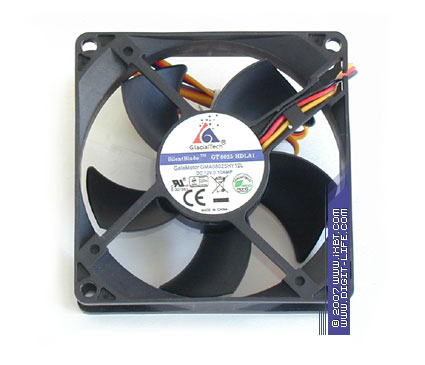 Parametric layout of the GT12025-HDLA1 is also interesting. Its impeller is notable for the reinforced aerodynamic profile on the front edge of blades (8% of the chord). It demonstrates low-noise design with a good performance potential — sweep and lean blades, the chord is 24 mm at the hub and 37 mm at the tip, chord-pitch ratio - 1.33 at the hub and 0.74 at the tip, angles of attack - 45° and 30°, 0.35 hub-tip ratio, 1.8 mm tip clearance. 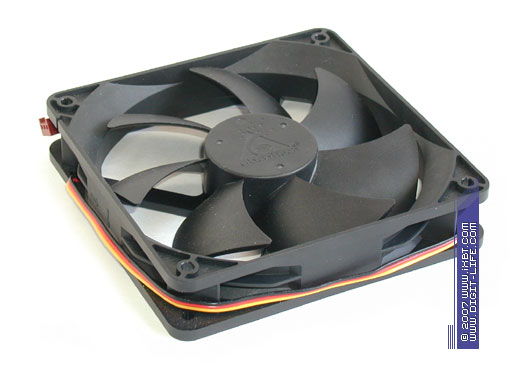
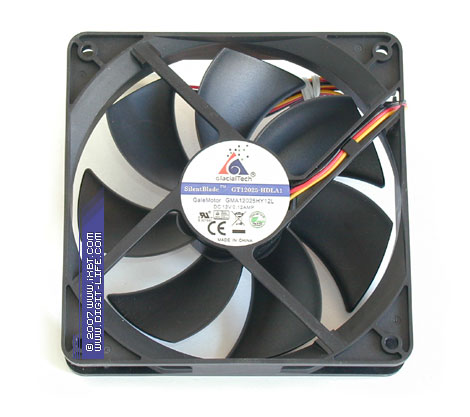 Mechanical outfit of the GT8025-HDLA1 and GT12025-HDLA1 adds much to their technical image — these fans are based on good hydrodynamic bearing with an almost classic configuration: the sleeve consists of three sections, its central part filled with grease (with increased inner diameter) has quasi-porous surface, the other two sections (of smaller diameter) have hydrodynamic surface (V-shaped grooves) to hold oil and ensure its recirculation. Additionally, the bearing unit is covered with a plastic lock on the backing plate of the stator, and spiced up with a dust cover on the hub side. 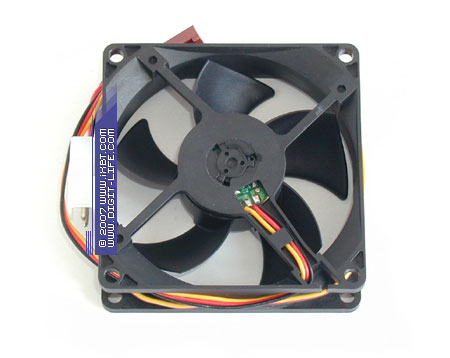 GT8025-HDLA1 and GT12025-HDLA1 look neat in electric terms as well: although the engine binding is based on the simple S211 chip (however, it's better in some parameters than the ATS276/277 chips popular in the budget segment). A neat inductor and smoothing capacitors at the output of coil drivers improve the situation — the electric popping in the fan noise is still noticeable, but it's quieter than in Arctic Cooling Arctic Fan 8L or Cooler Master SAF-S12-E1-GP. 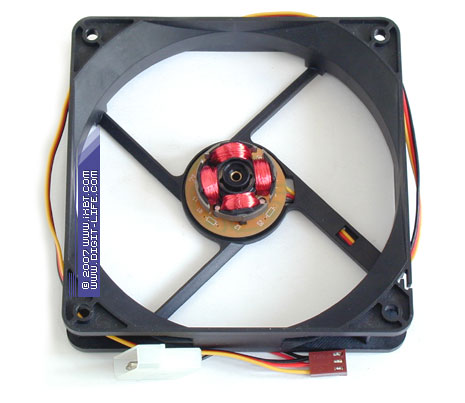 And the most comforting moment — these models are good not only in technical terms, but also from the practical point of view. The GT8025-HDLA1 demonstrates the best results at 1500 rpm among the 80x80x25 mm models tested. And it achieves the best efficiency/noise ratio in the standard mode. The GT12025-HDLA1 also looks very good at 700 rpm and 1000 rpm. It's practically on a par in efficiency with the strongest competitor — Scythe Minebea. At standard speed (1000 rpm) it takes the baton from the GT8025-HDLA1 and becomes the leader in efficiency/noise ratio in its class. What concerns the other two SilentBlade II models (GT8025-EDLA1 and GT12025-EDLA1), they practically copy aerodynamic and technical features of the GT8025-HDLA1 and GT12025-HDLA1, except for mechanics (they use sleeve bearing instead of hydrodynamic bearing). 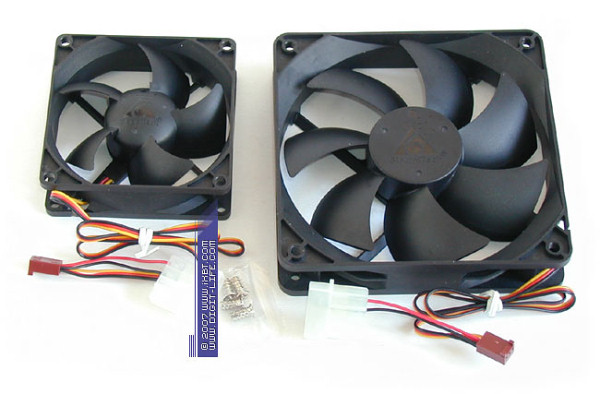 At the same time, this bearing (entering bearing) is also technically elegant — in fact, it's not solid, it consists of two sleeves. The external hardmetal sleeve covers the internal sleeve (made of soft alloy), which has quasi-porous surface with good wettability to hold oil. We should give the manufacturer (GaleMotor) its due — this is both low-consumption and quite efficient solution (with prolonged service life of fan's mechanics). Our today's shootout also includes SilentBlade II GT9025-HDLA1 and GT9025-EDLA1 models (92x92x25 mm) - they are hors concours. 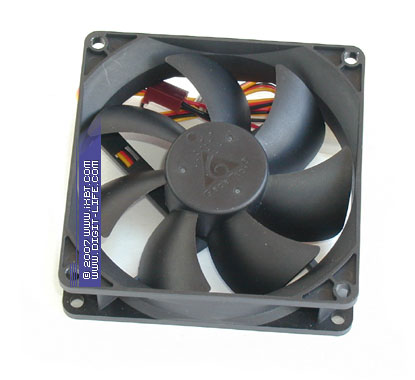
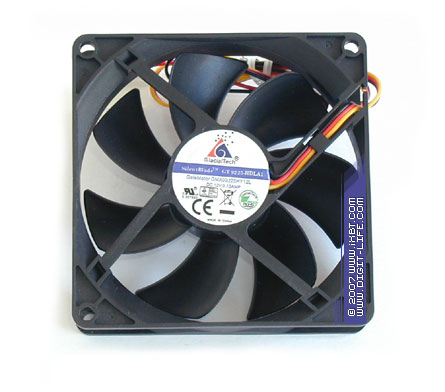 Electric and mechanical parts of these fans are similar to those of SilentBlade II 80x80x25 mm and 120x120x25 mm models ("HDLA" means hydrodynamic bearing, "EDLA" — entering bearing). What concerns aerodynamics, they are similar to 120x120x25 mm fans. We'll describe them in one of our future articles.
Contents:
Arctic Cooling fans were kindly provided by Arctic Cooling
Vitali Crinitsin (vit@ixbt.com) June 8, 2007 Write a comment below. No registration needed!
|
Platform · Video · Multimedia · Mobile · Other || About us & Privacy policy · Twitter · Facebook Copyright © Byrds Research & Publishing, Ltd., 1997–2011. All rights reserved. |